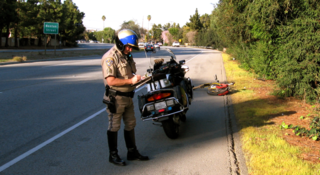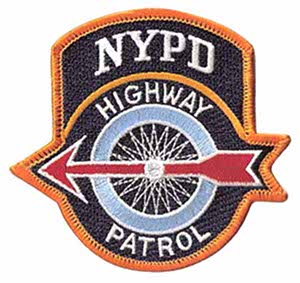
The Metropolitan Police Service (MPS), formerly and still commonly referred to as the Metropolitan Police, is the territorial police force responsible for law enforcement and the prevention of crime within the ceremonial county of Greater London. In addition, it is responsible for some specialised matters throughout the United Kingdom, including national counter-terrorism measures and the protection of specific people, such as the monarch and other members of the royal family, members of the government, and other officials.

A highway patrol is a police unit, detail, or law enforcement agency created primarily for the purpose of overseeing and enforcing traffic safety compliance on roads and highways within a jurisdiction. They are also referred to in many countries as traffic police, although in other countries this term is more commonly used to refer to foot officers on point duty who control traffic at junctions.

The Highway Patrol are specialized units part of the Highway District with the Transportation Bureau of the New York City Police Department. The Highway Patrol is primarily responsible for patrolling and maintaining traffic safety on limited-access highways within New York City. The Highway Patrol's other duties and roles include accident investigations, advanced driver and radar/laser speed enforcement training for NYPD officers, field sobriety testing at the various testing locations in each Patrol Borough, dignitary and parade escorts, hazardous material and truck traffic enforcement, anti-drag racing programs, and anti-terrorist checkpoints at key bridges and intersections in the city.

Traffic police are police officers, units, and agencies who enforce traffic laws and manage traffic. Traffic police include police who patrol highways, direct traffic, and address traffic infractions. They may be a separate agency from a main police agency, a unit or division within a police agency, or a type of assignment issued to officers; they can also be part of a transportation authority or highway authority.
The Territorial Support Group (TSG) is a Met Operations unit of London's Metropolitan Police Service (MPS) which specialises in public order policing, amongst other specialist areas. In 2012 it consisted of 793 officers and 29 support staff. The TSG is a uniformed unit of the MPS that replaced the similarly constituted Special Patrol Group in 1987. TSG units patrol the streets of London in marked police vans or "carriers"; using the call sign prefix "Uniform". Generally each carrier has an advanced (police) driver, seven constables and a sergeant. Territorial Support Groups often comprise three carriers, twenty one constables, and three sergeants reporting to an Inspector. They separately patrol designated areas experiencing serious levels of gang violence or disorder. When deployed, it is by the MPS Information Room. Due to the public order nature of their role often numerous carriers will be assigned. TSG officers can be identified as TSG from the distinctive "U" in their shoulder numbers. Some TSG officers are also plainclothes officers, carrying a taser and handcuffs.
A firearms unit is an armed unit within each territorial police force in the United Kingdom. For the most part, the police forces of the United Kingdom are unarmed; however, all have firearms units to provide the police force with the capability to deal with terrorists and armed criminals. A police officer cannot apply to join the firearms unit without first finishing their two-year probationary period, with a further two years in a core policing role for some forces. Firearms unit is the most common name outside of the capital, while that of London's Metropolitan Police Service is called the Specialist Firearms Command, Trojan or SC&O19. Within the media it is sometimes compared to the SWAT units of the United States.

A police motorcycle is a motorcycle used by police and law enforcement. They may be custom designed to meet the requirements unique of a particular use. A police motorcycle is often called "bacon on 2 wheels" in the United States. Units that use motorcycles are often called motorcycle units or motor units, and police officers assigned to these units are known as motorcycle officers or motor officers.

The York Regional Police (YRP) is the police service of the Regional Municipality of York, Ontario, Canada. YRP was formed in 1971 from the police forces maintained by the nine municipalities which amalgamated into York Region at the time. The force had a strength of over 1,500 sworn members and 618 unsworn members as of 2015.

Essex Police is a territorial police force responsible for policing the county of Essex, in the East of England. Essex Police is responsible for a population of over 1.8 million people and an area of 1,420 square miles (3,700 km2).

The Hampshire and Isle of Wight Constabulary is the territorial police force responsible for policing the counties of Hampshire and the Isle of Wight in South East England.
The Roads and Transport Policing Command, formerly the Safer Transport Command and Transport Operational Command Unit, is a unit of the London Metropolitan Police Service that polices roads, buses, bus routes, taxis and minicabs. It does not police national railways in London, London Underground, Docklands Light Railway or Tramlink, which fall under the remit of the British Transport Police (BTP).
Territorial Operations was a group of eighteen specialist Metropolitan Police units which were set up in 1986 as part of Sir Kenneth Newman's restructuring of the Metropolitan Police Service. The Territorial Operations units were designed to support the Metropolitan Police areas—while area-based policing was designed to decentralise the operations of New Scotland Yard, the TO units were intended to provide central operational and logistic support to Areas and divisional OCUs.

The Polícia de Segurança PúblicaMHTE is the national civil police force of Portugal. Part of the Portuguese security forces, the mission of the PSP is to defend Republican democracy, safeguarding internal security and the rights of its citizens. Despite many other functions, the force is generally known for policing urban areas with uniformed police officers, while rural areas are normally policed by National Republican Guard (GNR), the country's national gendarmerie force. PSP is focused in preventive policing, only investigating minor crimes. Investigation of serious crimes falls under the Judicial Police responsibility, which is a separate agency.
The Aviation Policing Command (APC) now renamed as Aviation Security Operational Unit (SO18) is a Specialist Operations unit of London's Metropolitan Police Service. The unit is responsible for providing policing and security for both Heathrow and London City airports. London's other airports, Gatwick, Stansted and Luton are policed by Sussex, Essex, and Bedfordshire Police respectively, as they are not located in the Metropolitan Police District.
MetCC, also known as the Met Contact Centre, Met Command and Control or MO12, is a department of Met Operations within Greater London's Metropolitan Police Service. It is responsible for receiving emergency and non-emergency public telephony within the Metropolitan Police and between the police and the public & other forces, and for the despatching of police to incidents. MetCC operates out of three centres in Lambeth, Hendon and Bow.

Police in the United Kingdom use a wide range of operational vehicles, including compact cars, powerful estates and armoured police carriers. The main uses are patrol, response, tactical pursuit, and public order policing. Other vehicles used by British police include motorcycles, aircraft, and boats.

National Police Corps, colloquially in English as Dutch National Police or National Police Force, is divided in ten regional units, a central unit, the police academy, police services center, and national dispatch center cooperation. The law-enforcement purposes of these agencies are the investigation of suspected criminal activity, referral of the results of investigations to the courts, and the temporary detention of suspected criminals pending judicial action. Law enforcement agencies, to varying degrees at different levels of government and in different agencies, are also commonly charged with the responsibilities of deterring criminal activity and preventing the successful commission of crimes in progress. The police commissioner in the Netherlands is Henk van Essen since May 1, 2020.

The New York City Police Department (NYPD) is structured into numerous bureaus and units. As a whole, the NYPD is headed by the Police Commissioner, a civilian administrator appointed by the Mayor, with the senior sworn uniformed officer of the service titled "Chief of Department". The Police Commissioner appoints the First Deputy Commissioner as the department's second-in-command and the Chief of Department as the department's highest ranking uniformed officer. The commissioner also appoints a number of deputy and assistant commissioners who do not have operational command and are solely for support and administrative function. The department is divided into twenty bureaus, six of which are enforcement bureaus. Each enforcement bureau is further subdivided into sections, divisions, and units, and into patrol boroughs, precincts, and detective squads. Each bureau is commanded by a bureau chief. There are also a number of specialized units that are not part of any of the bureaus and report to the Chief of the Department.
The London Borough of Redbridge Parks Police Service was a body of constables responsible for policing the parks and open spaces in the London Borough of Redbridge. The service was headed by Chief Officer John Boylin, the former Metropolitan Police Borough Commander for Redbridge. Policing was provided by two shifts, each consisting of one sergeant and six constables. On 31 October 2011, the service was disbanded and replaced by a Council-funded team of Metropolitan Police officers known as the "Redbridge Community Police Team".

The Garda National Roads Policing Bureau (GNRPB) (Irish: Póilínú Bóithre) is the roads policing unit of the Garda Síochána. Prior to 2018, it was known as the Garda Traffic Corps.












